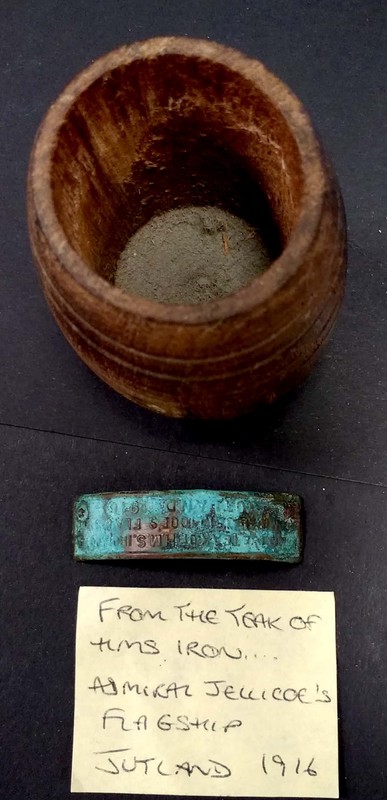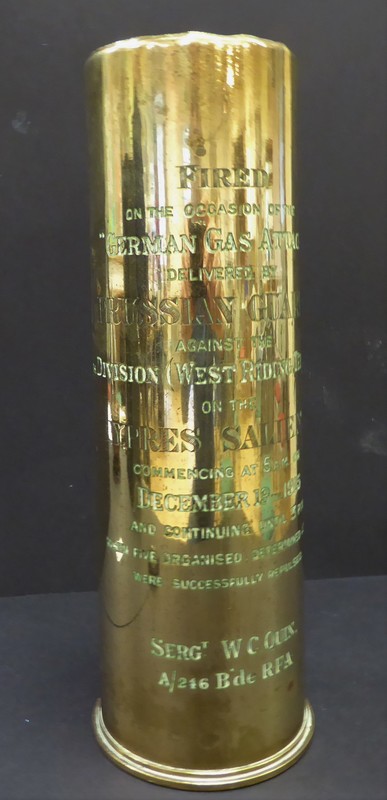George Jonathan Oldroyd (photographs; shell case; barrel)
Item
Title
George Jonathan Oldroyd (photographs; shell case; barrel)
Who?
George Jonathan Oldroyd
Item(s)
Photograph of a shell case with inscription; barrel made from teak from Lord Jellico's flagship.
Admiral Jellicoe’s teak barrel; Photo of Sgt. Quinn; Shell case from German gas attack that belonged to Sgt. Quinn; Photos of war in Mesopotamia (Iraq), with notes on the back. 24 cards; Photo of George Oldroyd in Belgium; Photos of Forest Row training camp.
Admiral Jellicoe’s teak barrel; Photo of Sgt. Quinn; Shell case from German gas attack that belonged to Sgt. Quinn; Photos of war in Mesopotamia (Iraq), with notes on the back. 24 cards; Photo of George Oldroyd in Belgium; Photos of Forest Row training camp.
Story
George Jonathan Oldroyd served in the British Army and survived World War I. His dates are: 23.09.1893 – 23.12. 1983.
He served in the Ypres Salient. He was wounded by the phosgene gas attack on December 19 1915. Kathleen, his niece, is trying to find out more about his army service. (See note.)
He owned the teak barrel. It is not known how that object came to him. The miniature teak barrel with a metal name-plate is made from the teak of HMS Iron Duke, the flagship of Sir John Jellicoe at the Battle of Jutland, Commander in Chief of the British Grand Fleet, May 31 – June 1 1916.
The shell case: the shell was fired in repulse of a German gas attack by Sgt. Quinn. (The Quinn family no longer wished to keep it, and during a house-clearing it passed to Kathleen Dixon.)
Note: The German Phosgene attack (19 December 1915), was the first use of phosgene gas against British troops by the German army. The gas attack took place at Wieltje, north-east of Ypres in Belgian Flanders on the Western Front in the First World War. German gas attacks on Allied troops had begun on 22 April 1915, during the Second Battle of Ypres using chlorine against French and Canadian units.
A German Non-commissioned officer of the XXVI Reserve Corps, which held the German line between the Ypres–Roulers and Ypres–Staden railway lines, was captured near Ypres on the night of 4/5 December. The prisoner said that gas cylinders had been dug into the corps front and that a gas attack had recently been postponed. Information had been gleaned from another source that a gas attack was to be made on the Flanders front after 10 December, when the weather was favourable.
At 5:00 a.m. on December 19, an unusual parachute flare was seen to rise from the German lines and at 5:15 a.m., red rockets, which were so unusual that British sentries gave the alert, rose all along the XXVI Reserve Corps front. Soon afterwards, a hissing was heard and a smell noticed. On the left flank, in the 49th Division area which had the 146th and 147th brigades in the line, no man's land was only 20 yd (18 m) wide in places and small-arms fire was received from the German trenches, before the gas discharge.
Small numbers of German troops were seen to advance from the German line; in one place about twelve men moved forward in single file and at another place about 30 soldiers attacked. A party managed to reach the British parapet, before being overwhelmed but the rest were shot down in no man's land.
The German gas discharge on the front from Boesinghe to Pilckem and Verlorenhoek was followed by twenty raiding parties, which were to observe the effect of the gas and to lift prisoners and equipment. Only two patrols were able to reach the British line according to German sources and several parties had many losses to British return-fire. The gas formed a white cloud about 50 ft (15 m) high and lasted for thirty minutes, before a freshening north-easterly wind blew it away. The effect was felt over a large area, because the cloud spread outwards from the 3 mi (4,800 m) width of the attack front, to about 8 mi (13 km) further back. The gas cloud moved for about 10 mi (16 km), almost as far as Bailleul. Around 6:15 a.m., green rockets were fired from the German front line and the British lines were bombarded by gas shells, which moved quietly through the air and only exploded with a "dull splash". In the 49th Division area, some troops in support trenches were asleep and were gassed before they could be woken but most were able to don their helmets in time. (Wikipedia)
He served in the Ypres Salient. He was wounded by the phosgene gas attack on December 19 1915. Kathleen, his niece, is trying to find out more about his army service. (See note.)
He owned the teak barrel. It is not known how that object came to him. The miniature teak barrel with a metal name-plate is made from the teak of HMS Iron Duke, the flagship of Sir John Jellicoe at the Battle of Jutland, Commander in Chief of the British Grand Fleet, May 31 – June 1 1916.
The shell case: the shell was fired in repulse of a German gas attack by Sgt. Quinn. (The Quinn family no longer wished to keep it, and during a house-clearing it passed to Kathleen Dixon.)
Note: The German Phosgene attack (19 December 1915), was the first use of phosgene gas against British troops by the German army. The gas attack took place at Wieltje, north-east of Ypres in Belgian Flanders on the Western Front in the First World War. German gas attacks on Allied troops had begun on 22 April 1915, during the Second Battle of Ypres using chlorine against French and Canadian units.
A German Non-commissioned officer of the XXVI Reserve Corps, which held the German line between the Ypres–Roulers and Ypres–Staden railway lines, was captured near Ypres on the night of 4/5 December. The prisoner said that gas cylinders had been dug into the corps front and that a gas attack had recently been postponed. Information had been gleaned from another source that a gas attack was to be made on the Flanders front after 10 December, when the weather was favourable.
At 5:00 a.m. on December 19, an unusual parachute flare was seen to rise from the German lines and at 5:15 a.m., red rockets, which were so unusual that British sentries gave the alert, rose all along the XXVI Reserve Corps front. Soon afterwards, a hissing was heard and a smell noticed. On the left flank, in the 49th Division area which had the 146th and 147th brigades in the line, no man's land was only 20 yd (18 m) wide in places and small-arms fire was received from the German trenches, before the gas discharge.
Small numbers of German troops were seen to advance from the German line; in one place about twelve men moved forward in single file and at another place about 30 soldiers attacked. A party managed to reach the British parapet, before being overwhelmed but the rest were shot down in no man's land.
The German gas discharge on the front from Boesinghe to Pilckem and Verlorenhoek was followed by twenty raiding parties, which were to observe the effect of the gas and to lift prisoners and equipment. Only two patrols were able to reach the British line according to German sources and several parties had many losses to British return-fire. The gas formed a white cloud about 50 ft (15 m) high and lasted for thirty minutes, before a freshening north-easterly wind blew it away. The effect was felt over a large area, because the cloud spread outwards from the 3 mi (4,800 m) width of the attack front, to about 8 mi (13 km) further back. The gas cloud moved for about 10 mi (16 km), almost as far as Bailleul. Around 6:15 a.m., green rockets were fired from the German front line and the British lines were bombarded by gas shells, which moved quietly through the air and only exploded with a "dull splash". In the 49th Division area, some troops in support trenches were asleep and were gassed before they could be woken but most were able to don their helmets in time. (Wikipedia)
When?
December 1915
Where?
N.E. Ypres
Contributor
Kathleen Dixon, niece to George Jonathan Oldroyd
Collection Day
November 3 2018 Menston
This item was submitted on February 6, 2019



